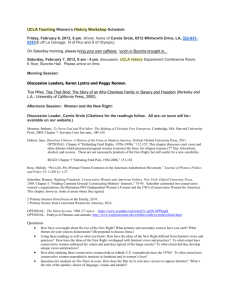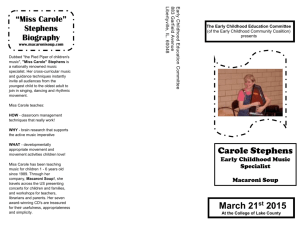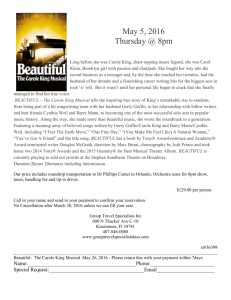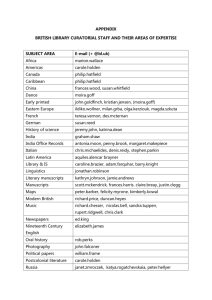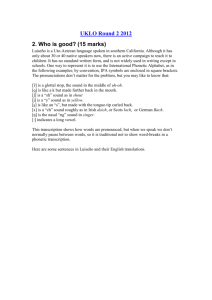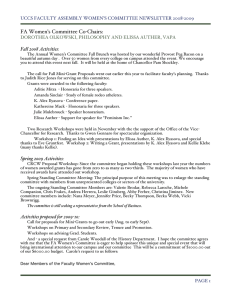ULAM’S PATHOLOGICAL LIAR GAME WITH ONE HALF-LIE
advertisement
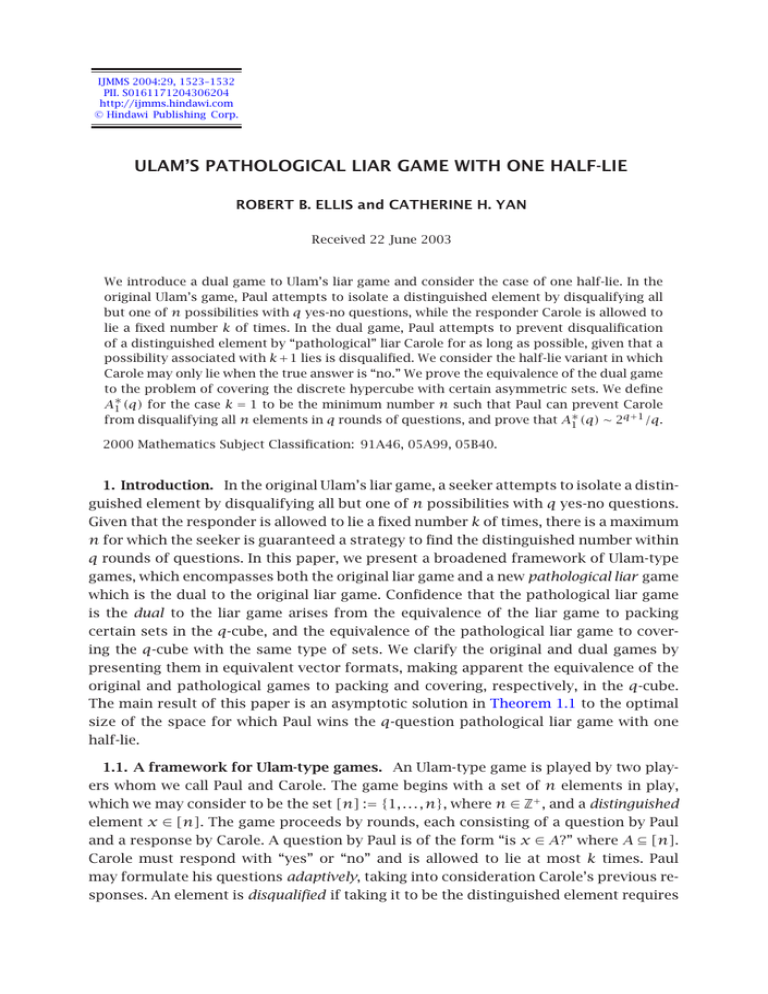
IJMMS 2004:29, 1523–1532
PII. S0161171204306204
http://ijmms.hindawi.com
© Hindawi Publishing Corp.
ULAM’S PATHOLOGICAL LIAR GAME WITH ONE HALF-LIE
ROBERT B. ELLIS and CATHERINE H. YAN
Received 22 June 2003
We introduce a dual game to Ulam’s liar game and consider the case of one half-lie. In the
original Ulam’s game, Paul attempts to isolate a distinguished element by disqualifying all
but one of n possibilities with q yes-no questions, while the responder Carole is allowed to
lie a fixed number k of times. In the dual game, Paul attempts to prevent disqualification
of a distinguished element by “pathological” liar Carole for as long as possible, given that a
possibility associated with k+1 lies is disqualified. We consider the half-lie variant in which
Carole may only lie when the true answer is “no.” We prove the equivalence of the dual game
to the problem of covering the discrete hypercube with certain asymmetric sets. We define
A∗
1 (q) for the case k = 1 to be the minimum number n such that Paul can prevent Carole
q+1 /q.
from disqualifying all n elements in q rounds of questions, and prove that A∗
1 (q) ∼ 2
2000 Mathematics Subject Classification: 91A46, 05A99, 05B40.
1. Introduction. In the original Ulam’s liar game, a seeker attempts to isolate a distinguished element by disqualifying all but one of n possibilities with q yes-no questions.
Given that the responder is allowed to lie a fixed number k of times, there is a maximum
n for which the seeker is guaranteed a strategy to find the distinguished number within
q rounds of questions. In this paper, we present a broadened framework of Ulam-type
games, which encompasses both the original liar game and a new pathological liar game
which is the dual to the original liar game. Confidence that the pathological liar game
is the dual to the liar game arises from the equivalence of the liar game to packing
certain sets in the q-cube, and the equivalence of the pathological liar game to covering the q-cube with the same type of sets. We clarify the original and dual games by
presenting them in equivalent vector formats, making apparent the equivalence of the
original and pathological games to packing and covering, respectively, in the q-cube.
The main result of this paper is an asymptotic solution in Theorem 1.1 to the optimal
size of the space for which Paul wins the q-question pathological liar game with one
half-lie.
1.1. A framework for Ulam-type games. An Ulam-type game is played by two players whom we call Paul and Carole. The game begins with a set of n elements in play,
which we may consider to be the set [n] := {1, . . . , n}, where n ∈ Z+ , and a distinguished
element x ∈ [n]. The game proceeds by rounds, each consisting of a question by Paul
and a response by Carole. A question by Paul is of the form “is x ∈ A?” where A ⊆ [n].
Carole must respond with “yes” or “no” and is allowed to lie at most k times. Paul
may formulate his questions adaptively, taking into consideration Carole’s previous responses. An element is disqualified if taking it to be the distinguished element requires
1524
R. B. ELLIS AND C. H. YAN
Carole to have lied about it k+1 times. An element which is not yet disqualified is a surviving element. Without loss of generality, we assume that A consists only of surviving
elements. The game terminates when a specified condition is achieved, such as there
being at most 1 surviving element. Paul plays a strategy to either achieve or delay the
terminating condition, and Carole plays an adverse strategy to Paul. By this we think of
neither actually selecting the distinguished element x; instead, both play consistently
with at least one surviving element possibly being x.
1.2. The original liar game and its vector game equivalent. The original Ulam’s liar
game is a searching game in which Paul attempts to “find” the distinguished element x
in a minimum number of rounds by forcing disqualification of all other elements, while
Carole answers adversely. Carole does not pick x at the beginning but rather answers
consistently so that there is an x she could have picked. The game terminates when
there is exactly 1 surviving element, which is “found” by Paul; since Carole responds
adversely, the game will always terminate with 1 surviving element (never will all elements be disqualified). The largest n such that Paul can force game termination in q
rounds has been determined exactly in the cases of 1 lie [12], 2 lies [10], and 3 lies [7],
and asymptotically in the number of questions in [13]. In the half-lie variant of Ulam’s
liar game, Carole is only allowed to lie when the truthful answer is “no,” so that every
“no” Paul hears is truthful. Thus if Carole answers “yes,” no lies are assigned to elements of A, but 1 lie is assigned to each of the surviving elements in [n] \ A. If Carole
answers “no,” no lies are assigned to surviving elements of [n] \ A, but all elements of
A are disqualified. The case k = 1 for search spaces of size 2m is solved in [4], and an
asymptotic analysis in q for fixed k appears in [8] and is improved in [14].
The original liar game with k half-lies is equivalent to the following vector game,
which arises from an encoding due to Berlekamp [3]. The initial vector of the game on
n elements is the vector (n, 0, . . . , 0) with k + 1 entries. An intermediate state of the
= (x0 , x1 , . . . , xk ),
game after some number of rounds is represented by the vector x
where xi counts the number of elements of [n] associated with i lies. In particular, xi
is a nonnegative integer for all 0 ≤ i ≤ k. Disqualified elements are not counted, and
k
1 := i=0 xi counts the total number of surviving elements left in the game. The
so x
= (a0 , a1 , . . . , ak ), where ai
question “is x ∈ A?” by Paul is associated with the vector a
counts the number of elements in A associated with i lies. Clearly, 0 ≤ ai ≤ xi for all
positions 0 ≤ i ≤ k. If Carole answers “yes,” all elements in A stay in the same position
in the vector but all surviving elements in [n] \ A move one position to the right, as
they have become associated with an additional lie. An element moving to the right
from position k, the rightmost position, is disqualified and removed from the game.
If Carole answers “no,” she is not lying, and so all elements in A are disqualified and
removed entirely from the vector. Thus we define the new state vector based on the
Paul’s question a,
and Carole’s answer, as one of the following:
original state x,
a
:= a0 , a1 + x0 − a0 , . . . , ak + xk−1 − ak−1 ,
Y x,
(1.1)
a
:= x0 − a0 , x1 − a1 , . . . , xk − ak .
N x,
Therefore Paul wins the q-round game on n elements with k half-lies if the vector game
1 ≤ 1. For a state
with initial state (n, 0, . . . , 0) terminates in at most q rounds with x
ULAM’S PATHOLOGICAL LIAR GAME WITH ONE HALF-LIE
1525
define r (x)
to be the minimum number of rounds in the game starting in
vector x,
for which Paul has a winning strategy. Then r (x)
satisfies
state x
= 1 + min max r Y x,
a
, r N x,
a
r x
,
a
(1.2)
and r (x)
= 0 when x
1 ≤ 1. For
where the minimum is over all possible questions a,
all q ≥ 0, Ak (q) is defined to be the maximum n such that r ((n, 0, . . . , 0)) = q; that
is, Ak (q) is the maximum n such that Paul has a strategy to find the distinguished
element x in q rounds
in the k half-lie game. For fixed k, Ak (q) was shown in [8] to be
asymptotically 2q+k / qk .
1.3. The pathological half-liar game. In the pathological liar game, Paul attempts
to preserve the distinguished element x from disqualification for as long as possible,
while Carole lies “pathologically” to disqualify x. This time, we take the viewpoint dual
to that in the original game that Paul does not have to pick x at the beginning, but rather
asks questions consistent with there being an x he could have picked. We are concerned
with the half-lie variant, in which Carole is only allowed to lie when the truthful answer
is “no.” We first present the pathological half-lie game in its vector form which is dual
to that of the original half-lie game, and then discuss its interpretation. The analysis
of the pathological full-lie game is similar to that of the original full-lie game, and will
appear in [9].
The pathological half-liar game. The pathological liar game on n elements
with k half-lies has initial state (n, 0, . . . , 0) and terminating state (0, . . . , 0, 1), both (k +
1)-vectors. As before, the game progresses from initial to terminal state by means of
≤ x,
question/answer pairs, where a question by Paul is a nonnegative (k + 1)-vector a
is the previous state vector, and an answer by Carole is either “yes” or “no.”
where x
a)
:= (a0 , a1 + x0 − a0 , . . . , ak + xk−1 − ak−1 ) if Carole’s
As in (1.1), the next state is Y(x,
a)
:= (x0 − a0 , x1 − a1 , . . . , xk − ak ) if Carole’s answer is “no.”
answer is “yes” and N(x,
Paul plays to delay termination for as long as possible, while Carole can and does answer
adversely, always choosing the response which forces earlier game termination.
Note that the game will always reach the terminating state without first reaching
the zero vector, because otherwise Paul’s strategy is suboptimal; thus Paul’s goal is to
maximize the number of rounds for which the state vector is nonzero. For the state
to be the maximum number of rounds in the game with initial
define r ∗ (x)
vector x,
for which Paul can force the game to last; dually to (1.2), we have
state x
= 1 + max min r ∗ Y x,
a
, r ∗ N x,
a
r∗ x
,
a
(1.3)
= 0.
and r ∗ ((0, . . . , 0, 1)) = r ∗ (0)
where the maximum is over all possible questions a,
∗
∗
For all q ≥ 0, Ak (q) is defined to be the minimum n such that r ((n, 0, . . . , 0)) = q; that
is, A∗
k (q) is the minimum n such that Paul has a strategy to delay game termination for
q rounds in the k half-lie game. Having a larger k actually helps Paul prolong the game,
as it increases the threshold for Carole to disqualify any given element.
1526
R. B. ELLIS AND C. H. YAN
Interpreted in the original game form, the pathological game on n elements corresponds to Paul seeking to preserve a distinguished element x ∈ [n] from disqualification for as long as possible, with Carole answering adversely. Answers of “yes” and
“no” by Carole to the question “is x ∈ A?” are processed as in the original game, either by assigning an additional lie to surviving elements in [n] \ A or by immediately
disqualifying all elements of A, respectively (i.e., an answer of “yes” by Carole may be
truthful or mendacious, but an answer of “no” by her is always thought to be truthful).
We remark that under this interpretation, if Paul asks “is x ∈ B?” where B is the set of
all surviving elements, then a response “no” by Carole would immediately disqualify
all elements and hence end the game.
Under this interpretation, the max and min in (1.3) correspond to Paul choosing the
to which Carole’s most disruptive answer allows at least one element to
question a
survive for as long as possible. The state (0, . . . , 0, 1, 0, . . . , 0), in which there is exactly
1 surviving element which is not in position k, is not terminal, because Paul may ask
the question “is x ∈ ∅?” to which Carole responds with “yes,” since responding with
“no” does not change the state of the game. Furthermore, by the remark at the end of
the previous paragraph, it is suboptimal for Paul to ask the question “is x ∈ B?” where
B is the set of surviving elements, because Carole can immediately end the game by
answering “no.”
Paul wins a q-round game on n elements with k half-lies if he can prevent the game
from terminating before the completion of q rounds, or, in other words, if he can preserve at least one element for q rounds. In this paper, we are concerned with the pathological half-lie variant in the case k = 1. For a fixed q ≥ 0, define A∗
1 (q) to be the
minimum n such that Paul has a strategy to win the q-round pathological liar game
in which Carole is allowed one half-lie. We prove the following asymptotic behavior of
A∗
1 (q).
Theorem 1.1. Let q > 0. Then
A∗
1 (q) ∼
2q+1
.
q
(1.4)
The proof of Theorem 1.1 is divided into the remaining sections of the paper. In
Section 2, we show the equivalence of the pathological liar game with one half-lie to a
problem of covering the q-dimensional hypercube with certain asymmetric sets called
1-sets. The asymptotic lower bound for A∗
1 (q) follows from a sphere-bound argument
in Section 4. An inductive constructive upper bound is given in Section 5, for which we
generate a base case in Section 3 by computing A∗
1 (q) for small values of q.
2. Equivalence to covering by 1-sets. In this section, we prove the equivalence of
the existence of a strategy for Paul to win the q-round pathological liar game on n
elements with one half-lie to the existence of a cover of the q-cube with certain socalled 1-sets. Define Qq := {N, Y}q to be the q-dimensional hypercube, where we think
of 1’s being associated with N’s and 0’s with Y’s. A 1-set consists of the following:
(i) a stem ω = ω1 ω2 · · · ωq ∈ Qq with r N’s at positions j1 , . . . , jr , where 0 ≤ r ≤ q,
(ii) exactly r children C1 , . . . , Cr such that Ck ∈ ω1 · · · ωjk −1 YQq−jk .
ULAM’S PATHOLOGICAL LIAR GAME WITH ONE HALF-LIE
1527
Thus a child is obtained from the stem by changing some “N” to “Y” and choosing the
remaining sequence to the right arbitrarily. For example, {NNY, YYN, NYY} is a 1-set
with stem NNY. A collection Ꮿ of 1-sets is a covering of Qq provided ∪S∈Ꮿ S = Qq .
The proof of the following theorem is similar to that of [8, Theorem 2.4], but is
adjusted for the pathological half-liar game and specialized to the case of one half-lie.
Theorem 2.1. Let q ≥ 0. Paul has a strategy for winning the q-round pathological
liar game with one half-lie on n elements if and only if there exists a covering of Qq with
n 1-sets.
Proof. For the forward implication, Paul’s winning strategy corresponds to a decision tree which is a full binary tree of depth q and has a question at each nonleaf node.
The left child of a node corresponds to a response of “no” by Carole, while the right
corresponds to “yes.” A game played under this strategy is a path from the root to a leaf
of the decision tree, passing down q levels of questions by Paul and answers by Carole.
The leaves of the decision tree correspond to the vertices of Qq , and a leaf is labeled
with the surviving elements in the game determined by the path from the root to that
leaf. Because the strategy is a winning strategy, every leaf is associated with at least
one element of [n]. Now let Pi be the set of paths from the root to any leaf associated
with i, and label each path with Carole’s corresponding response sequence. Exactly one
path ω ∈ Pi corresponds to all truthful responses by Carole; this ω is the candidate
stem for Pi as a 1-set. Every other ω
∈ Pi must agree with ω up until some position in
which ω has an “N” and ω
has a “Y,” after which there is a unique way to complete ω
so that i is associated with only one lie. Every position in which ω has an “N” results
in an ω
of this form, and so Pi is a 1-set. Therefore the collection Ꮿ = {Pi : i ∈ [n]} is
a cover of Qq by n 1-sets.
For the reverse implication, let Ꮿ = {Pi : i ∈ [n]} be a collection of n 1-sets, which
covers Qq . Label the leaf corresponding to the path ω ∈ {Y, N}q with i if ω ∈ Pi , whence
each of the 2q leaves has at least one label. At each node z of the decision tree, define
L(z) to be the set of labels of leaves of the left subtree of z, and associate with z the
question “is x ∈ [n]\L(z)?” We claim that these questions comprise a winning strategy
for Paul.
Consider an arbitrary response sequence ω by Carole, and assume to the contrary
that ω associates all elements labeling the leaf corresponding to ω with 2 or more
lies. The leaf corresponding to w is labeled by at least one element of [n]; let i be
such a label, so that w ∈ Pi . By assumption, i is associated with at least two lies; let
1 ≤ s < t ≤ q be the positions of these lies in Carole’s response sequence. Since Carole
may only lie by responding with “Y” when the truthful answer is “N,” there must exist
a, b ∈ Pi of the following form:
a = a1 · · · as−1 N · · · ,
b = a1 · · · as−1 Ybs+1 · · · bt−1 N · · · ,
(2.1)
w = a1 · · · as−1 Ybs+1 · · · bt−1 Y · · · .
Clearly, it is impossible for Pi to be a 1-set if any of a, b, or w is the stem. Neither can
there be a distinct stem c ∈ Pi , since c would have a1 · · · as−1 N as a prefix, and could
1528
R. B. ELLIS AND C. H. YAN
Table 3.1. Values of A∗
1 (q), the minimum number of elements n for which
Paul can win the q-round pathological liar game with one half-lie, versus
K + (q, 1), the minimum number of asymmetric balls of radius 1 needed to
cover Qq .
q
1
A∗
1 (q)
+
1
2
3
5
8
13
22
1
2
3
6
10
18
31
K (q, 1)
2
3
4
q
8
A∗
1 (q)
+
39
71
129
239
58
93–106
162–229
306–433
K (q, 1)
9
10
11
5
12
6
7
13
14
444
831
1561
563–668
1046–1285
—
not support the two children a and b, both obtained by changing position s from “N”
to “Y.” This contradicts the assumption that Pi is a 1-set, and so i must be associated
with at most one lie. Therefore Paul wins the game with response sequence ω because
i is not disqualified.
In fact, a more general version of Theorem 2.1 is true. In [8], an i-set was defined as
the set of all possible response sequences by Carole about an element, which contain
at most i lies. It is straightforward to extend the proof of Theorem 2.1 to show that
Paul has a strategy to win the pathological game with k half-lies in q rounds starting in
position (x0 , . . . , xk ) if and only if there exists a simultaneous covering of Qq with xi
(k − i)-sets, where 0 ≤ i ≤ k.
Related to a 1-set with stem w is the asymmetric ball with radius 1 centered at w,
which we denote by B − (w, 1) (cf. [6]). B − (w, 1) is defined to be the set of all w ∈ {Y, N}8
obtained from w by changing at most one “N” to “Y” and leaving the remaining positions
fixed. Thus such an asymmetric ball centered at w is always a 1-set with stem w, but not
vice versa. We note without proof that a cover of Qq by n asymmetric balls corresponds
to a nonadaptive strategy for Paul to win the q-round pathological liar game on n
elements with one half-lie.
3. A∗
1 (q) for small values of q. Using the vector game formulation and the definition of r ∗ ((n, 0)) in (1.3), a moderately optimized dynamic programming algorithm
computes A∗
1 (q) exactly for small values of q. The corresponding critical value for
minimum coverings of Qq by asymmetric balls is K + (q, 1), defined to be the minimum
number of asymmetric balls of radius 1 needed to cover Qq . Table 3.1 presents A∗
1 (q)
versus K + (q, 1) for 1 ≤ q ≤ 13; the data on K + (q, 1) is due to [2, 6] and private communication with G. Exoo. The current bound on K + (14, 1) is very poor and is thus omitted.
The dynamic programming algorithm for A∗
1 (q) is polynomial in n but exponential in
q; further optimization or greater computing resources should be able to determine
A∗
1 (q) up to at least q = 20. Determination of more than a few additional values of
K + (q, 1), on the other hand, seems very difficult. A key question is whether the ratio
K + (q, 1)/A∗
1 (q) converges to 1 as q → ∞, or if there is an absolute constant C > 1 such
that lim supq→∞ K + (q, 1)/A∗
1 (q) ≥ C.
1529
ULAM’S PATHOLOGICAL LIAR GAME WITH ONE HALF-LIE
NNNN
NNNY
NNYY
NYNY
NYYY
NYNN
NNYN
YNNY
NYYN
YNYY
YYNY
YNNN
YYNN
YNYN
YYYN
YYYY
Figure 3.1. The hypercube Q4 has an asymmetric cover consisting of 6 asymmetric balls of radius 1, centered at the gray rectangular vertices; children of
ball centers are connected upward to their respective parents by bold lines. In
relaxing to a cover by 1-sets, the child of NNNN obtained from changing the
first “N” to “Y” can be taken as YYYY instead of YNNN, yielding an optimal
1-set cover of size 5.
Because an asymmetric ball of radius 1 in Qq is also a 1-set, covering Qq with 1sets is a relaxation of covering Qq with asymmetric 1-balls. Therefore, for all q, we
+
have A∗
1 (q) ≤ K (q, 1). Figure 3.1 illustrates the first disagreement occurring at q = 4
between a minimum cover of asymmetric 1-balls of size 6 centered at NNNN, NNNY,
YNNN, NYYN, YNNY, and YYYY and a minimum 1-set cover of size 5 (listed with stems
first):
{NNNN, YYYY, NYNN, NNYN, NNNY}, {NNNY, YNNY, NYNY, NNYY},
{YNNN, YYNN, YNYN, YNNY}, {NYYN, YYYN, NYYY}, {YNNY, YYNY, YNYY} .
(3.1)
The two covers are nearly identical, except that in the first 1-set, YYYY is taken to
be the child of NNNN with respect to the first coordinate, rather than YNNN in the
first asymmetric 1-ball. Thus the extra flexibility in the definition of a 1-set allows a
smaller cover. The value A∗
1 (7) will be used in Section 5 as the base case of an inductive
construction for an upper bound on A∗
1 (q).
4. An asymptotic sphere lower bound. A sphere bound for the number of 1-sets
needed to cover Qq is obtained by dividing the size of the space to be covered, 2q , by
the size of a typical 1-set. Since, asymptotically, most vertices of Qq are concentrated
in the middle with approximately q/2 N’s, we expect the stem of a typical 1-set to have
about q/2 N’s. However, a covering by 1-sets might use stems with a large number of
N’s more than once; we negotiate this concern by arguing about the maximum number
of typical vertices with approximately q/2 N’s which can be contained in a 1-set, evenq+1
/q)(1 + o(1)) is
tually confirming that an asymptotic sphere bound on A∗
1 (q) of (2
appropriate.
Define a vertex w in Qq to be rare if it contains more than (q + q ln q)/2 N’s.
The Chernoff inequality gives that if X1 , . . . , Xq are independently distributed random
q
variables with Pr[Xi = 0] = Pr[Xi = 1] = 1/2, then for any α > 0, Pr[ i=1 Xi > (q +
2
α)/2] < e−α /2q (see, e.g., [1, Theorem A.1.1]). Choosing α = k q ln q bounds the number
1530
R. B. ELLIS AND C. H. YAN
of rare vertices in Qq from above with 2q q−k
following.
2 /2
. By taking k = 1, we have proved the
Lemma 4.1. For q ≥ 1, the number of nonrare vertices of Qq is at least 2q (1 − q−1/2 ).
We now count the largest number of nonrare vertices in a 1-set to bound A∗
1 (q).
Theorem 4.2. For q ≥ 1,
A∗
1 (q)
2q+1
ln q
1−O
.
≥
q
q
(4.1)
Proof. The stem w of a 1-set is either nonrare or rare. If w is nonrare, then it
has at most (q + q ln q)/2 N’s, and so the total number of nonrare vertices in the
1-set cannot exceed 1 + (q + q ln q)/2, which is the size of the 1-set. Now suppose
w = w1 · · · wq is rare, and let r be the number of N’s in w, so that wj1 = · · · = wjr = N.
Each of w’s children corresponding to positions j(q+√q ln q)/2+2 , . . . , jr is rare, since the
1 + (q + q ln q)/2 N’s to the left remain unchanged. Therefore there are at most 1 +
(q + q ln q)/2 nonrare vertices among the remaining children.
In either case, a 1-set has at most 1 + (q + q ln q)/2 nonrare vertices, and so, by
Lemma 4.1, the number of 1-sets required for a cover of Qq is at least
ln q
2q+1
2q 1 − q−1/2
=
1−O
.
(4.2)
q
q
1 + q + q ln q /2
The result follows by Theorem 2.1.
For general coding theory problems, the sphere bound is obtained by dividing the
size of the space by the size of a typical set used to pack or cover the space; therefore
the sphere bound is an upper bound for the packing problem and a lower bound for
the covering problem. For instance, the sphere bound
for symmetric binary covering
R and packing codes of size n and radius R is 2n / i=0 ni (see, e.g., [5, Theorem 6.1.2]).
A major outstanding question for symmetric codes is whether covering and packing
codes meet at the sphere bound for radius R > 1. A definitive, exact sphere bound
unifying asymmetric binary covering and packing codes has not been settled, but an
exact sphere bound for the asymmetric covering problem appears in [6, Theorem
2],
n/2
n
and corresponds to a candidate unifying asymptotic sphere bound of 2 / R in [11].
It is completely open for all R > 0 whether or not optimal asymmetric codes meet at
this candidate asymptotic sphere bound. Therefore the asymptotic sphere bound of
(2q+1 /q)(1 + o(1)) in Theorem 4.2 is important because it is met by both packing and
covering by 1-sets, which are relaxations of radius R = 1 asymmetric binary packing and
covering, respectively. The case of Ulam’s pathological liar game and the corresponding
asymptotic sphere bound for k lies will be studied in [9].
5. A constructive upper bound. The asymptotic upper bound for A∗
1 (q) is constructive, and arises from taking a known efficient cover for Qq of sufficiently small size and
building it into an efficient cover for Qq+1 .
Theorem 5.1. For all q ≥ 1,
∗
A∗
1 (q + 1) ≤ 2A1 (q) −
2
A∗
1 (q)
.
2q
(5.1)
ULAM’S PATHOLOGICAL LIAR GAME WITH ONE HALF-LIE
1531
Proof. Let Ꮿ = {S1 , . . . , SA∗1 (q) } be a collection of 1-sets of size A∗
1 (q) which cover Qq .
Because vertices of Qq may lie in overlapping 1-sets, construct the reduced collection
Ꮿ = {S 1 , . . . , S A∗1 (q) } of subsets of 1-sets by defining S i = Si \ ∪j<i Sj . In particular, Ꮿ
partitions Qq .
Define NᏯ := {{Nω : ω ∈ S} : S ∈ Ꮿ} and YᏯ := {{Yω : ω ∈ S} : S ∈ Ꮿ}. Certainly,
NᏯ ∪ YᏯ is a size 2A∗
1 (q) cover for Qq+1 which is extendible to a 1-set cover. But in
extending NᏯ to be a collection of 1-sets, each member NS ∈ NᏯ covers an arbitrary
vertex in YQq by changing the first “N” to “Y” and arbitrarily choosing the rest; A∗
1 (q)
arbitrary vertices in YQq may be covered in this fashion. Therefore we may still extend
NᏯ ∪ YᏯ to a 1-set cover of Qq+1 when some members of YᏯ are removed so that no
more than A∗
1 (q) vertices of YQq are left uncovered by the remaining members of YᏯ.
∗
2
q
The average size of a member of YᏯ is 2q /A∗
1 (q), and so there must exist A1 (q) /2 ∗
∗
∗
2
q
q
reduced 1-sets in YᏯ which cover at most A1 (q) /2 ·(2 /A1 (q)) ≤ A1 (q) vertices of
∗
2
q
YQq . Now construct a 1-set cover for Qq+1 of size 2A∗
1 (q) − A1 (q) /2 by removing
∗
these members of YᏯ, covering the at most A1 (q) exposed vertices in YQq by members
of NᏯ, and extending all sets arbitrarily to be 1-sets.
An analysis of the recurrence of Theorem 5.1 yields the following upper bound on
A∗
1 (q).
Corollary 5.2. For all q ≥ 7,
A∗
1 (q) <
2
2q+1
1−
.
q
q
(5.2)
2
q
Proof. Define f (q) by f (7) = A∗
1 (7), and f (q +1) = 2f (q)−f (q)/2 +1 for q ≥ 7,
∗
so that f (q) is an upper bound for A1 (q), for all q ≥ 7. Define αq := f (q)/(2q+1 /q).
The recurrence for f written in terms of αq is
αq+1
αq αq2
1
=
− 2 + q+2 .
q+1
q
q
2
(5.3)
The function y(x) = x/q −x 2 /q2 +1/2q+1 increases on (−∞, q/2], where q/2 ≥ 1 when
q ≥ 2. Referring to Table 3.1, note that α7 = 77/128 < 1−2/7. For q ≥ 7, if αq < 1−2/q,
2
αq+1 = (q + 1)y αq < (q + 1)y 1 −
q
2
1
2
2
1
1
= (q + 1)
1−
− 2 1−
+ q+2 .
q
q
q
q
2
(5.4)
Denoting the right-hand side by X, we have
1−
2
q3 − q2 + 4q + 4 q + 1
−X =
− q+2 ,
q+1
(q + 1)q4
2
(5.5)
which is at least 0 for q ≥ 7. Thus, by induction, αq < 1 − 2/q for all q ≥ 7.
The closeness of this upper bound to the lower bound is due to flexibility in the choice
of children for a given stem of a 1-set. The above analysis depends on knowing the exact
1532
R. B. ELLIS AND C. H. YAN
value of A∗
1 (7), but could be rewritten using a near-optimal cover Ꮿq for some q > 7,
provided |Ꮿq | ≤ 1 − 2/q. Furthermore, the choice of c = 2 in the bound αq < 1 − 2/q
corresponds to the base case q = 7; the induction goes through for a smaller but not
arbitrary c > 0 provided a sufficiently large base case can be found.
Acknowledgments. The authors wish to express their appreciation for the careful
review by the referee and the several useful comments which resulted. The first author
was supported in part by NSF Grant DMS-9977354. The second author was supported
by NSF Grant DMS-0070574 and a Sloan Fellowship. This author is also affiliated with
the Dalian University of Technology.
References
[1]
[2]
[3]
[4]
[5]
[6]
[7]
[8]
[9]
[10]
[11]
[12]
[13]
[14]
N. Alon and J. H. Spencer, The Probabilistic Method, 2nd ed., Wiley-Interscience Series in
Discrete Mathematics and Optimization, John Wiley & Sons, New York, 2000.
D. Applegate, E. M. Rains, and N. J. A. Sloane, On asymmetric coverings and covering numbers, J. Combin. Des. 11 (2003), no. 3, 218–228.
E. R. Berlekamp, Block coding for the binary symmetric channel with noiseless, delayless
feedback, Error Correcting Codes (Proc. Sympos. Math. Res. Center, Madison, Wis,
1968), John Wiley & Sons, New York, 1968, pp. 61–88.
F. Cicalese and D. Mundici, Optimal coding with one asymmetric error: below the sphere
packing bound, Computing and Combinatorics (Sydney, 2000), Lecture Notes in
Comput. Sci., vol. 1858, Springer, Berlin, 2000, pp. 159–169.
G. Cohen, I. Honkala, S. Litsyn, and A. Lobstein, Covering Codes, North-Holland Mathematical Library, vol. 54, North-Holland Publishing, Amsterdam, 1997.
J. N. Cooper, R. B. Ellis, and A. B. Kahng, Asymmetric binary covering codes, J. Combin.
Theory Ser. A 100 (2002), no. 2, 232–249.
C. Deppe, Solution of Ulam’s searching game with three lies or an optimal adaptive strategy
for binary three-error-correcting codes, Discrete Math. 224 (2000), no. 1–3, 79–98.
I. Dumitriu and J. Spencer, A Halfliar’s game, Theoret. Comput. Sci. 313 (2004), no. 3,
353–369.
R. B. Ellis, V. Ponomarenko, and C. H. Yan, The Rényi-Ulam Pathological Liar Game with a
Fixed Number of Lies, preprint, 2003.
W. Guzicki, Ulam’s searching game with two lies, J. Combin. Theory Ser. A 54 (1990), no. 1,
1–19.
M. Krivelevich, B. Sudakov, and V. H. Vu, Covering codes with improved density, IEEE Trans.
Inform. Theory 49 (2003), no. 7, 1812–1815.
A. Pelc, Solution of Ulam’s problem on searching with a lie, J. Combin. Theory Ser. A 44
(1987), no. 1, 129–140.
J. Spencer, Ulam’s searching game with a fixed number of lies, Theoret. Comput. Sci. 95
(1992), no. 2, 307–321.
J. Spencer and C. H. Yan, The halflie problem, J. Combin. Theory Ser. A 103 (2003), no. 1,
69–89.
Robert B. Ellis: Department of Mathematics, Texas A&M University, College Station, TX 778433368, USA.
E-mail address: rellis@math.tamu.edu
Catherine H. Yan: Department of Mathematics, Texas A&M University, College Station, TX
77843-3368, USA.
E-mail address: cyan@math.tamu.edu
